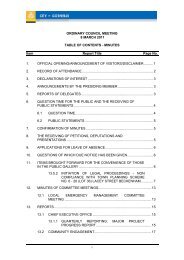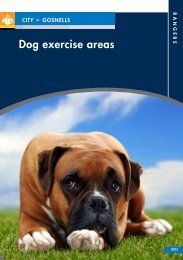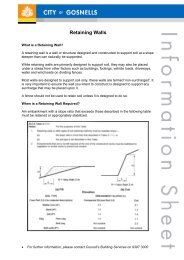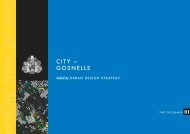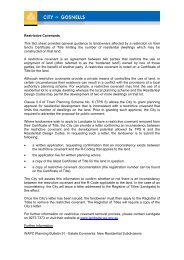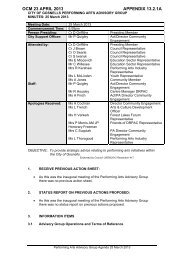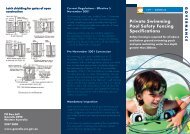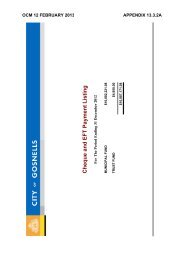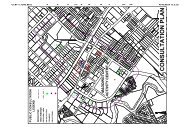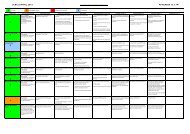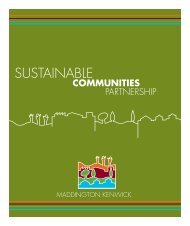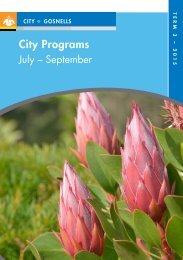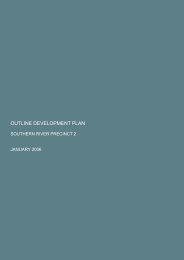Summary - City of Gosnells
Summary - City of Gosnells
Summary - City of Gosnells
You also want an ePaper? Increase the reach of your titles
YUMPU automatically turns print PDFs into web optimized ePapers that Google loves.
Flora 47Family HaemodoraceaeConostylis festucacea subsp. festucacea. On the Swan Coastal Plain this perennial herb occurs in PinjarraPlain clay-based wetlands from the Anstey/Keane Dampland and Adjacent Bushland (BFS 342) inForrestdale and extends north to the southern end <strong>of</strong> the Geraldton Sandplains Bioregion. The populations inthe Perth area are disjunct from other occurrences.Family JuncaginaceaeTriglochin muelleri. This annual herb is endemic to the SCP region and is associated with claypans fromCooljarloo to Busselton (B.J. Keighery, pers. comm.). Near Busselton it is found in Tuart Forest Reserve -Ludlow State Forest (Simpson Wetland) and at Fish Road, Yoongarillup and Ruabon Bushlands.Family MalvaceaeLawrencia squamata. This is a spinescent shrub that can grow to about 1 m in height and grows in sandy,saline, gypsum and limestone soils on wetland flats and depressions. It occurs in only two, disjunct areas onthe Swan Coastal Plain; both (Bullsbrook and Cannington-Kenwick) are near Perth. Otherwise, the species iswidespread in semi-arid and arid regions, especially northern and eastern parts <strong>of</strong> the Southwest BotanicalProvince and the south-western quarter <strong>of</strong> the Eremaean Botanical Province.Family MimosaceaeAcacia lasiocarpa var. lasiocarpa sens. strict. Of the several forms <strong>of</strong> Acacia lasiocarpa that are currentlyinformally grouped under the name <strong>of</strong> Acacia lasiocarpa var. lasiocarpa and occur on the Swan CoastalPlain, the form that was recorded in the current survey <strong>of</strong> the MKSEA most closely matches the type concept<strong>of</strong> Acacia lasiocarpa var. lasiocarpa (Maslin, 1975; B. Maslin, pers. comm.).Family Myrtaceae1. Eucalyptus decipiens subsp. decipiens. The main habitat <strong>of</strong> this mallee on the SCP is sand over TamalaLimestone in near-coastal areas <strong>of</strong> the SCP. However, it also occurs (much more rarely) as disjunctpopulations on the Pinjarra Plain on the eastern side <strong>of</strong> the SCP, where it is an indicator <strong>of</strong> MucheaLimestone (Keighery and Keighery, 1995). The occurrence in the current survey <strong>of</strong> the MKSEA is verysignificant as this species and Muchea Limestone were not known previously from the vicinity <strong>of</strong> BFS387.2. Eucalyptus gomphocephala (Tuart). The main habitat <strong>of</strong> this large tree on the SCP is sand over TamalaLimestone in near-coastal areas. Some <strong>of</strong> the occurrences <strong>of</strong> this species that were recorded in thecurrent survey <strong>of</strong> the MKSEA at Victoria Rd, although large mature trees, were obviously trees thathave been planted by landowners. However, some <strong>of</strong> the Tuarts in the MKSEA occur in areas wherethere is calcareous material (that may be Muchea Limestone) in adjacent drainage channels. All <strong>of</strong> theoccurrences <strong>of</strong> Tuart in the MKSEA require detailed assessment to determine if they are naturaloccurrences associated with Muchea Limestone (and thus <strong>of</strong> very high conservation significance) or not.3. Hypocalymma angustifolium Mud Habitat Variant (C. Tauss 1850). The MKSEA and BFS 387populations <strong>of</strong> this undescribed taxon are significant because this species is a dominant component <strong>of</strong>many vegetation units in these areas. This taxon inhabits muddy palusplains, in contrast to the form <strong>of</strong>Hypocalymma angustifolium that is prevalent on the SCP (but is relatively uncommon in Kenwick) andinhabits peaty to humic sand on the margins <strong>of</strong> sumplands and damplands.4. Melaleuca brevifolia. This species is widespread in the south-west <strong>of</strong> Western Australian including theGeraldton Sandplains, Swan Coastal Plain, Avon Wheatbelt, Mallee and Esperance Plains Bioregions. Itis uncommon on the Swan Coastal Plain where it occurs in a small number <strong>of</strong> disjunct populations inwetlands <strong>of</strong> the Pinjarra Plain. The most northerly occurrence <strong>of</strong> this taxon is at the Bullsbrook NatureReserve and the adjacent bushland (BFS 292). The most southerly occurrence is at Kemerton Bushland.Several <strong>of</strong> the wetlands inhabited by Melaleuca brevifolia on the SCP are recognised as occurrences <strong>of</strong>the Muchea Limestone Threatened Ecological Community.Tauss, C. and Weston, A.S. (2010). The flora, vegetation and wetlands <strong>of</strong> the Maddington-Kenwick Strategic Employment Area.A survey <strong>of</strong> the rural lands in the vicinity <strong>of</strong> the Greater Brixton Street Wetlands. Report to the <strong>City</strong> <strong>of</strong> <strong>Gosnells</strong>, W.A. Version 18.04.10



